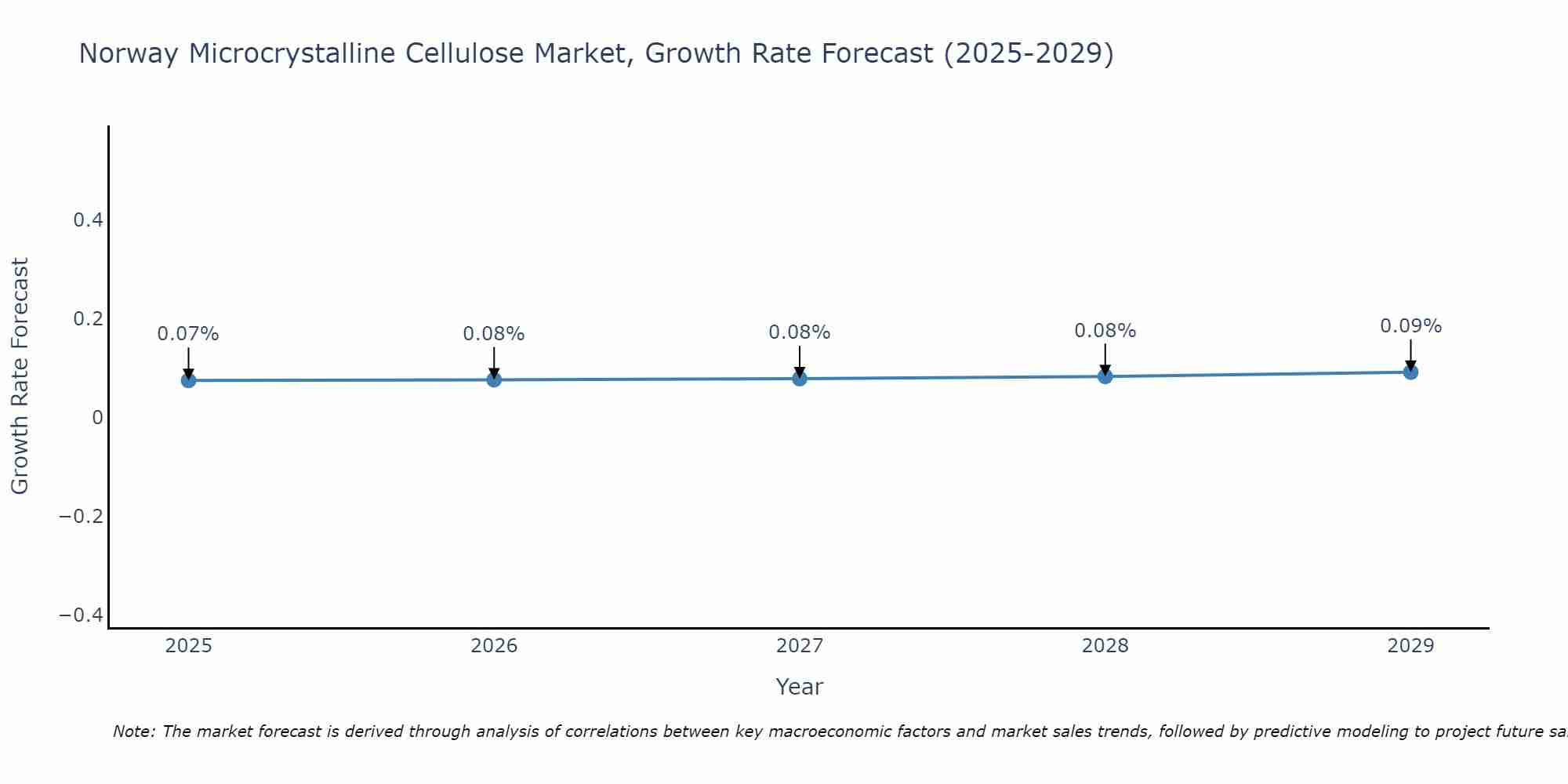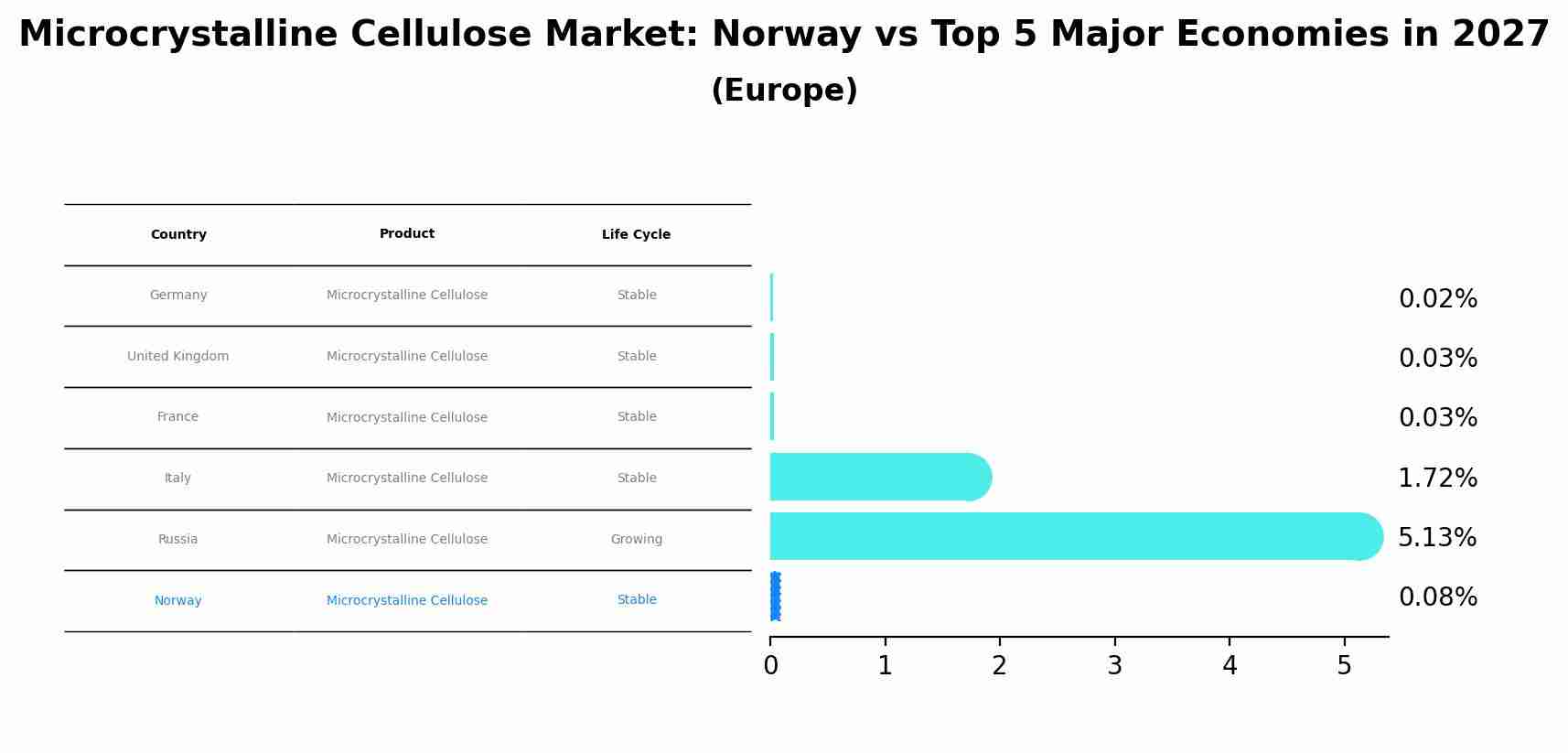Norway Microcrystalline Cellulose Market (2025-2031) | Size, Value, Share, Outlook, Growth, Industry, Segmentation, Forecast, Companies, Trends, Revenue & Analysis
| Product Code: ETC4756694 | Publication Date: Nov 2023 | Updated Date: Sep 2025 | Product Type: Market Research Report | |
| Publisher: 6Wresearch | Author: Sachin Kumar Rai | No. of Pages: 60 | No. of Figures: 30 | No. of Tables: 5 |
Norway Microcrystalline Cellulose Market Size Growth Rate
The Norway Microcrystalline Cellulose Market is likely to experience consistent growth rate gains over the period 2025 to 2029. The growth rate starts at 0.07% in 2025 and reaches 0.09% by 2029.

Microcrystalline Cellulose Market: Norway vs Top 5 Major Economies in 2027 (Europe)
The Microcrystalline Cellulose market in Norway is projected to grow at a stable growth rate of 0.08% by 2027, within the Europe region led by Germany, along with other countries like United Kingdom, France, Italy and Russia, collectively shaping a dynamic and evolving market environment driven by innovation and increasing adoption of emerging technologies.

Norway Microcrystalline Cellulose Market Overview
The microcrystalline cellulose market in Norway deals with the production and use of a refined form of cellulose used as a filler, binder, or stabilizer in various products, including pharmaceuticals, food, and cosmetics. Microcrystalline cellulose is valued for its purity and functional properties. Market growth is driven by the increasing demand for natural and effective ingredients in consumer products, advancements in production techniques, and the expansion of applications in different industries. The focus on quality and regulatory compliance continues to influence the market.
Drivers of the market
The Norway Microcrystalline Cellulose market is influenced by its use as an excipient in pharmaceuticals, a thickener in food products, and a binder in various industrial applications. The growing pharmaceutical and food industries drive demand for microcrystalline cellulose due to its functional properties. Additionally, advancements in production technologies and the increasing focus on natural and safe ingredients contribute to market growth.
Challenges of the market
The microcrystalline cellulose market in Norway is challenged by fluctuations in raw material prices and regulatory pressures. The production of microcrystalline cellulose depends on cellulose, which can experience price volatility. Additionally, increasing regulatory requirements for the use of cellulose in various applications can impact market dynamics and production costs.
Government Policy of the market
In Norway, the microcrystalline cellulose market is regulated to ensure the safety and quality of this ingredient, particularly in the food and pharmaceutical industries. The government enforces compliance with EU regulations on food additives and pharmaceutical excipients. Regulations include safety standards for production, labeling requirements, and guidelines for use in various applications.
Key Highlights of the Report:
- Norway Microcrystalline Cellulose Market Outlook
- Market Size of Norway Microcrystalline Cellulose Market, 2024
- Forecast of Norway Microcrystalline Cellulose Market, 2031
- Historical Data and Forecast of Norway Microcrystalline Cellulose Revenues & Volume for the Period 2021-2031
- Norway Microcrystalline Cellulose Market Trend Evolution
- Norway Microcrystalline Cellulose Market Drivers and Challenges
- Norway Microcrystalline Cellulose Price Trends
- Norway Microcrystalline Cellulose Porter`s Five Forces
- Norway Microcrystalline Cellulose Industry Life Cycle
- Historical Data and Forecast of Norway Microcrystalline Cellulose Market Revenues & Volume By Source Type for the Period 2021-2031
- Historical Data and Forecast of Norway Microcrystalline Cellulose Market Revenues & Volume By Non-Wood Based for the Period 2021-2031
- Historical Data and Forecast of Norway Microcrystalline Cellulose Market Revenues & Volume By Wood-Based for the Period 2021-2031
- Historical Data and Forecast of Norway Microcrystalline Cellulose Market Revenues & Volume By End-use for the Period 2021-2031
- Historical Data and Forecast of Norway Microcrystalline Cellulose Market Revenues & Volume By Binder/Diluent for the Period 2021-2031
- Historical Data and Forecast of Norway Microcrystalline Cellulose Market Revenues & Volume By Bulking agent for the Period 2021-2031
- Historical Data and Forecast of Norway Microcrystalline Cellulose Market Revenues & Volume By Emulsifiers for the Period 2021-2031
- Historical Data and Forecast of Norway Microcrystalline Cellulose Market Revenues & Volume By Stabilizer for the Period 2021-2031
- Historical Data and Forecast of Norway Microcrystalline Cellulose Market Revenues & Volume By Anti-Caking Agent for the Period 2021-2031
- Historical Data and Forecast of Norway Microcrystalline Cellulose Market Revenues & Volume By Others for the Period 2021-2031
- Historical Data and Forecast of Norway Microcrystalline Cellulose Market Revenues & Volume By Application for the Period 2021-2031
- Historical Data and Forecast of Norway Microcrystalline Cellulose Market Revenues & Volume By Pharmaceutical for the Period 2021-2031
- Historical Data and Forecast of Norway Microcrystalline Cellulose Market Revenues & Volume By Food & Beverage for the Period 2021-2031
- Historical Data and Forecast of Norway Microcrystalline Cellulose Market Revenues & Volume By Cosmetics & Personal Care for the Period 2021-2031
- Historical Data and Forecast of Norway Microcrystalline Cellulose Market Revenues & Volume By Paints & coatings for the Period 2021-2031
- Historical Data and Forecast of Norway Microcrystalline Cellulose Market Revenues & Volume By Others for the Period 2021-2031
- Norway Microcrystalline Cellulose Import Export Trade Statistics
- Market Opportunity Assessment By Source Type
- Market Opportunity Assessment By End-use
- Market Opportunity Assessment By Application
- Norway Microcrystalline Cellulose Top Companies Market Share
- Norway Microcrystalline Cellulose Competitive Benchmarking By Technical and Operational Parameters
- Norway Microcrystalline Cellulose Company Profiles
- Norway Microcrystalline Cellulose Key Strategic Recommendations
Frequently Asked Questions About the Market Study (FAQs):
1 Executive Summary |
2 Introduction |
2.1 Key Highlights of the Report |
2.2 Report Description |
2.3 Market Scope & Segmentation |
2.4 Research Methodology |
2.5 Assumptions |
3 Norway Microcrystalline Cellulose Market Overview |
3.1 Norway Country Macro Economic Indicators |
3.2 Norway Microcrystalline Cellulose Market Revenues & Volume, 2021 & 2031F |
3.3 Norway Microcrystalline Cellulose Market - Industry Life Cycle |
3.4 Norway Microcrystalline Cellulose Market - Porter's Five Forces |
3.5 Norway Microcrystalline Cellulose Market Revenues & Volume Share, By Source Type, 2021 & 2031F |
3.6 Norway Microcrystalline Cellulose Market Revenues & Volume Share, By End-use, 2021 & 2031F |
3.7 Norway Microcrystalline Cellulose Market Revenues & Volume Share, By Application, 2021 & 2031F |
4 Norway Microcrystalline Cellulose Market Dynamics |
4.1 Impact Analysis |
4.2 Market Drivers |
4.2.1 Growing demand for sustainable and eco-friendly products in various industries such as pharmaceuticals, food beverage, and cosmetics. |
4.2.2 Technological advancements leading to the development of innovative applications for microcrystalline cellulose. |
4.2.3 Government initiatives promoting the use of renewable and biodegradable materials in manufacturing processes. |
4.3 Market Restraints |
4.3.1 Fluctuations in raw material prices impacting the overall production cost of microcrystalline cellulose. |
4.3.2 Stringent regulatory requirements related to the production and use of microcrystalline cellulose in different applications. |
5 Norway Microcrystalline Cellulose Market Trends |
6 Norway Microcrystalline Cellulose Market Segmentations |
6.1 Norway Microcrystalline Cellulose Market, By Source Type |
6.1.1 Overview and Analysis |
6.1.2 Norway Microcrystalline Cellulose Market Revenues & Volume, By Non-Wood Based, 2021-2031F |
6.1.3 Norway Microcrystalline Cellulose Market Revenues & Volume, By Wood-Based, 2021-2031F |
6.2 Norway Microcrystalline Cellulose Market, By End-use |
6.2.1 Overview and Analysis |
6.2.2 Norway Microcrystalline Cellulose Market Revenues & Volume, By Binder/Diluent, 2021-2031F |
6.2.3 Norway Microcrystalline Cellulose Market Revenues & Volume, By Bulking agent, 2021-2031F |
6.2.4 Norway Microcrystalline Cellulose Market Revenues & Volume, By Emulsifiers, 2021-2031F |
6.2.5 Norway Microcrystalline Cellulose Market Revenues & Volume, By Stabilizer, 2021-2031F |
6.2.6 Norway Microcrystalline Cellulose Market Revenues & Volume, By Anti-Caking Agent, 2021-2031F |
6.2.7 Norway Microcrystalline Cellulose Market Revenues & Volume, By Others, 2021-2031F |
6.3 Norway Microcrystalline Cellulose Market, By Application |
6.3.1 Overview and Analysis |
6.3.2 Norway Microcrystalline Cellulose Market Revenues & Volume, By Pharmaceutical, 2021-2031F |
6.3.3 Norway Microcrystalline Cellulose Market Revenues & Volume, By Food & Beverage, 2021-2031F |
6.3.4 Norway Microcrystalline Cellulose Market Revenues & Volume, By Cosmetics & Personal Care, 2021-2031F |
6.3.5 Norway Microcrystalline Cellulose Market Revenues & Volume, By Paints & coatings, 2021-2031F |
6.3.6 Norway Microcrystalline Cellulose Market Revenues & Volume, By Others, 2021-2031F |
7 Norway Microcrystalline Cellulose Market Import-Export Trade Statistics |
7.1 Norway Microcrystalline Cellulose Market Export to Major Countries |
7.2 Norway Microcrystalline Cellulose Market Imports from Major Countries |
8 Norway Microcrystalline Cellulose Market Key Performance Indicators |
8.1 Research and development investment in new applications of microcrystalline cellulose. |
8.2 Percentage of market growth attributed to the adoption of microcrystalline cellulose in new industries. |
8.3 Sustainability metrics such as carbon footprint reduction achieved through the use of microcrystalline cellulose in place of traditional materials. |
9 Norway Microcrystalline Cellulose Market - Opportunity Assessment |
9.1 Norway Microcrystalline Cellulose Market Opportunity Assessment, By Source Type, 2021 & 2031F |
9.2 Norway Microcrystalline Cellulose Market Opportunity Assessment, By End-use, 2021 & 2031F |
9.3 Norway Microcrystalline Cellulose Market Opportunity Assessment, By Application, 2021 & 2031F |
10 Norway Microcrystalline Cellulose Market - Competitive Landscape |
10.1 Norway Microcrystalline Cellulose Market Revenue Share, By Companies, 2024 |
10.2 Norway Microcrystalline Cellulose Market Competitive Benchmarking, By Operating and Technical Parameters |
11 Company Profiles |
12 Recommendations | 13 Disclaimer |
- Single User License$ 1,995
- Department License$ 2,400
- Site License$ 3,120
- Global License$ 3,795
Search
Thought Leadership and Analyst Meet
Our Clients
Related Reports
- Germany Breakfast Food Market (2026-2032) | Industry, Share, Growth, Size, Companies, Value, Analysis, Revenue, Trends, Forecast & Outlook
- Australia Briquette Market (2025-2031) | Growth, Size, Revenue, Forecast, Analysis, Trends, Value, Share, Industry & Companies
- Vietnam System Integrator Market (2025-2031) | Size, Companies, Analysis, Industry, Value, Forecast, Growth, Trends, Revenue & Share
- ASEAN and Thailand Brain Health Supplements Market (2025-2031) | Strategy, Consumer Insights, Analysis, Investment Trends, Opportunities, Growth, Size, Share, Industry, Revenue, Segments, Value, Segmentation, Supply, Forecast, Restraints, Outlook, Competition, Drivers, Trends, Demand, Pricing Analysis, Competitive, Strategic Insights, Companies, Challenges
- ASEAN Bearings Market (2025-2031) | Strategy, Consumer Insights, Analysis, Investment Trends, Opportunities, Growth, Size, Share, Industry, Revenue, Segments, Value, Segmentation, Supply, Forecast, Restraints, Outlook, Competition, Drivers, Trends, Demand, Pricing Analysis, Competitive, Strategic Insights, Companies, Challenges
- Europe Flooring Market (2025-2031) | Outlook, Share, Industry, Trends, Forecast, Companies, Revenue, Size, Analysis, Growth & Value
- Saudi Arabia Manlift Market (2025-2031) | Outlook, Size, Growth, Trends, Companies, Industry, Revenue, Value, Share, Forecast & Analysis
- Uganda Excavator, Crane, and Wheel Loaders Market (2025-2031) | Strategy, Consumer Insights, Analysis, Investment Trends, Opportunities, Growth, Size, Share, Industry, Revenue, Segments, Value, Segmentation, Supply, Forecast, Restraints, Outlook, Competition, Drivers, Trends, Demand, Pricing Analysis, Competitive, Strategic Insights, Companies, Challenges
- Rwanda Excavator, Crane, and Wheel Loaders Market (2025-2031) | Strategy, Consumer Insights, Analysis, Investment Trends, Opportunities, Growth, Size, Share, Industry, Revenue, Segments, Value, Segmentation, Supply, Forecast, Restraints, Outlook, Competition, Drivers, Trends, Demand, Pricing Analysis, Competitive, Strategic Insights, Companies, Challenges
- Kenya Excavator, Crane, and Wheel Loaders Market (2025-2031) | Strategy, Consumer Insights, Analysis, Investment Trends, Opportunities, Growth, Size, Share, Industry, Revenue, Segments, Value, Segmentation, Supply, Forecast, Restraints, Outlook, Competition, Drivers, Trends, Demand, Pricing Analysis, Competitive, Strategic Insights, Companies, Challenges
Industry Events and Analyst Meet
Whitepaper
- Middle East & Africa Commercial Security Market Click here to view more.
- Middle East & Africa Fire Safety Systems & Equipment Market Click here to view more.
- GCC Drone Market Click here to view more.
- Middle East Lighting Fixture Market Click here to view more.
- GCC Physical & Perimeter Security Market Click here to view more.
6WResearch In News
- Doha a strategic location for EV manufacturing hub: IPA Qatar
- Demand for luxury TVs surging in the GCC, says Samsung
- Empowering Growth: The Thriving Journey of Bangladesh’s Cable Industry
- Demand for luxury TVs surging in the GCC, says Samsung
- Video call with a traditional healer? Once unthinkable, it’s now common in South Africa
- Intelligent Buildings To Smooth GCC’s Path To Net Zero


















